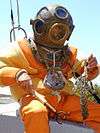Blood shift
Blood shift has at least two separate meanings:
- In medicine, it is synonymous with left shift.
- In biology, it may refer to a phenomenon that is seen when mammals submerge in water. It is part of the mammalian diving reflex. Blood vessels in the extremities contract, leaving a higher percentage of the entire blood volume in the torso. An effect that is important for freedivers is the resulting widening of the lung's capillaries. It reduces the lung's residual volume, thus increasing the depth at which the residual volume is reached (the average for untrained persons is about 30 meters, or 98.4 feet). According to Yasemin Dalkılıç, she can feel plasma enter her sinuses when diving to extreme depths while participating in free diving competitions. See also: immersion diuresis
Free diving
Mechanism
When the body is immersed, the diving reflex will contract the circular muscle in blood vessels of the arms and legs, reducing the total volume of blood vessels in the body. Therefore, a greater proportion of blood volume will remain in the torso, moved mainly in the pulmonary artery. This results in an increase in blood pressure, and shrinkage of the alveoli. The increased external pressure creates a pressure differential with the lungs, leading to a further influx of venous blood into the lung cavity. The blood vessels in the lungs expand and fill, and the alveoli contract still further.[1]
Practical implications
The maximum diving depth of the free diver is mainly determined by the ratio of the residual volume (RV) to the total lung capacity (TLC). The blood shift causes the lungs' capillary volume to expand resulting in a reduction of the residual volume and thus in an increase of the maximum possible depth. A redistribution of about 1.53 liters of blood to the pulmonary blood vessels has been shown. [1]
References
- 1 2 Claus-Martin Muth: Apnoetauchen - Gibt es medizinische Besonderheiten? 8. Bonner Tauchersymposium, 23. Februar 2008. (German)
Further reading
- Alfred A. Bove, Jefferson Carroll Davis: Bove and Davis' diving medicine. 4th edition, Saunders/Elsevier Health Sciences, 2004, ISBN 0-7216-9424-1
- Claus-Martin Muth, Peter Rademacher: Kompendium der Tauchmedizin. 2. Auflage, Deutscher Ärzteverlag, Köln 2007, ISBN 978-3-7691-1239-9
